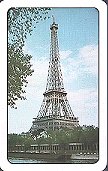 |
France is the country that gave birth to the
standard suit system based on Diamonds, Hearts, Clubs and Spades, now used all
over the world. But the same country is also the homeland of the interesting
French pattern, born in the early 1800s and known as portrait officiel. Another well-known variety sprung from the latter is the Belgian-Genoese pattern, described further down in the page.
In the classic French deck, each suit has an ace, pip cards from 7 to 10, and three courts
similar to the ones found in standard decks (knave, queen and king). In modern editions one joker
was added, therefore the total number of cards is now 33. The pack is used for playing Belote,
a game popular in France, but also known abroad; other traditional games which would require
this deck such as Manille, Bésigue (or Bezique) and Piquet, are
now barely played, or extinct. |
The indices are in French: V (Valet = knave),
D (Dame = queen) and R (Roi = king).
The ace instead is featured as number 1. Early editions did not have indices at all (see picture further down).
Some graphic details distinguish the French courts. A thick black diagonal line, with a row
of white beads as a decoration, doubles the characters. A large suit symbol, partially cut,
is repeated by the index in the left corner. In the right corner, instead, the small index
overlaps the most peculiar feature of the French pattern: the name of the court
character, which each of the 12 subjects has been traditionally identified with. The lettering
is in capital letters, black in colour for all four suits. |
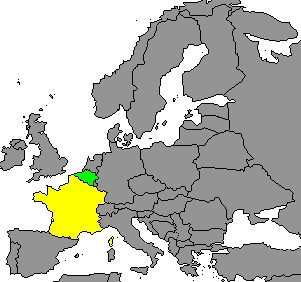 |
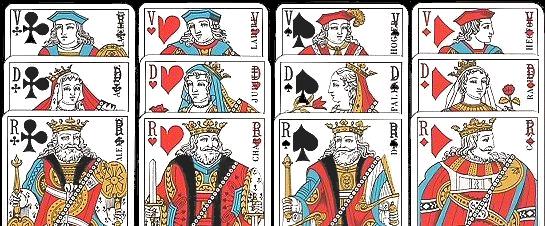
the courts shown above come from an edition manufactured by France Cartes
| courts |  |  |  |  |
|---|
| kings | ALEXANDRE | CHARLES | DAVID | CESAR |
|---|
| queens | ARGINE | JUDITH | PALLAS | RACHEL |
|---|
| jacks | LANCELOT | LA HIRE | HOGIER | HECTOR |
|---|
The origin of these names is fascinating, though still largely debated. Some of them are likely
to refer to historical characters, while others are rather obscure.
- Alexandre (king of Clubs) might be Alexander III the Great (356-323 BC), famous king of Macedonia;
- Charles (king of Hearts) might be Charlemagne (742-814), king of the Francs and, later, ruler of the Western Empire;
- David (king of Spades) is likely to refer to the second king of Israel (11th-10th century BC);
- Cesar (king of Diamonds) might be the famous roman general and dictator Julius Caesar (100-44 BC);
|
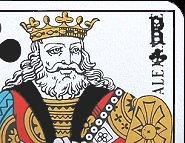 |
 |
- Argine (queen of Clubs) has an unknown origin, which some scholars suggest to be merely an anagram of Regina (Latin for "Queen");
- Judith (queen of Hearts) is probably the legendary Jewish heroine who saved her people from the Babylonians by seducing and later killing the enemy commander Holofernes;
- Pallas (queen of Spades) might refer to Athena, Greek goddess of war and
reason (Minerva to the Romans), whose other name was Pallas;
- Rachel (queen of Diamonds) appears to be another biblical character, one of the two wives of Jacob, son of Abraham;
|
- Lancelot (jack of Clubs) is almost certainly the most famous of king Arthur's knights of the Round Table;
- Lahire (jack of Hearts) is an obscure character, though
among the outstanding Frenchmen of the 17th century appear the names of
Laurent de La Hire (1606-1656, painter) and Philippe de Lahire
(1640-1718, mathematician and astronomer);
- Hogier (jack of Spades) is another unknown charachter;
- Hector (jack of Diamonds) appears more likely to be Launcelot's brother (one of king Arthur's knights, as well), rather
than the ancient Greek hero, son of king Priam, from Homer's Iliad.
A few more hypotheses about the names are suggested by Daf Tregear in her
Playing-cards Frequently Asked
Questions.
The earliest version of the
portrait officiel
was single-headed, but it soon turned into the double-headed pattern still
used today.
The indices only appeared in the early 1900s;
in older editions (such as the one on the right) the cards
had no numeral nor letter to show their value.
The fact of being additional details explains
why in modern editions they overlap the courts' names.
In the 19th century the French decks had another interesting feature: they did not carry
a tax stamp, as playing cards did in most other European countries, but
a watermark. The paper that the government officially sold to card-makers,
on which the playing card pattern was then printed, bore this distinctive
sign as the proof of the duty.
|
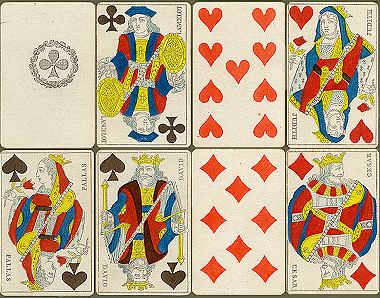
portrait officiel without indices, c.1860-70 (manufacturer not stated) |
Not considering the joker card (which is an extra subject, and only appeared
at the turn of the 20th century), the French composition is the same as
the one found in
Skat decks, discussed in the
German gallery.
In particular, among the German patterns, the
Berliner Bild
(also known as Französisches Bild, the most common one in northern Germany)
is even closer to the French cards, featuring Hearts, Spades,
Diamonds and Clubs instead of the more typical German suits; the design of the
courts, though, is rather different.
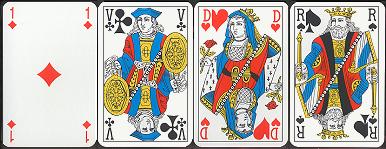
French pattern, 52-card edition without names (by Héron, France) |
Besides the aforesaid classic version, which some manufacturers now list in their
catalogues as Belote deck, the French pattern also exists in 52-card editions, for a more
general use; in this version the typical court names are often dropped, almost representing a French-Belgian hybrid (see the following paragraph). |
BELGIAN AND GENOESE PATTERNS
The French-speaking areas of Belgium play with a deck of cards
that is very similar to the one used in the neighbour country, but with a few differences:
|
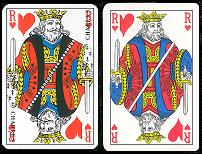
French pattern (left, by France Cartes),
and Belgian pattern (Carta Mundi, Belgium) |
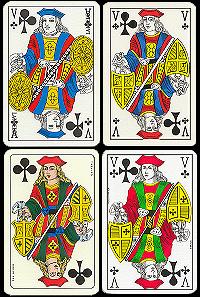 |
- the court personages' names never appear;
- the diagonal band doubling the courts in two halves has no beads, and is usually white;
- the knave of Clubs wears a red hat, whereas the French one has it in blue, and holds a
triangular shield, divided in quarters featuring heraldic symbols (usually a tower, a
rampant lion, a cross and a striped pattern), while the French one is oval, with hexagonal
and round decorations: a detail of the shields is shown further in the page);
- all Belgian court personages fill the white space slightly less than the French ones
(i.e. the latter are "roundish").
This pattern is available in both 32- and 52-card versions; the jokers added are usually two, but in the former case there may be only one, or none, according to the edition.
|
|
top row, from the left: French pattern (Dal Negro, Italy) and Belgian pattern (Carta Mundi, Belgium)
bottom row: Genoese pattern (Dal Negro, Italy) and Belgian pattern (Master De Lux, Turkey)
|
In spite of the fact that Flemish areas of Belgium do not use this design,
preferring the Dutch national pattern (not yet dealt with by the galleries),
it is interesting how other countries, either directly linked to French culture, such as Tunisia and Morocco, or with little or no connection to France, such as those in the south-east of Europe and in the Middle East (Turkey, Lebanon, Syria), have adopted the Belgian pattern, or a Belgian-derived one, as an alternative to the international one.
Turkey, in particular, is known to use the former design almost as a standard, keeping the French indices (V, D and R), despite the suits and the courts are locally referred to with Turkish names (see
glossary at the end of the page). |
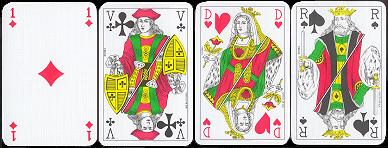
above: Belgian pattern, Master De Luxe brand, Turkey;
below: Belgian-Genoese pattern, by Biermans (Belgium)
for Tunisia, c.1950: North African editions frequently have sharp corners
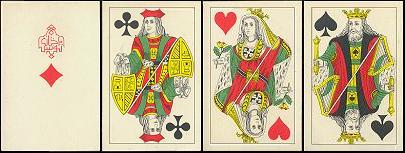
|
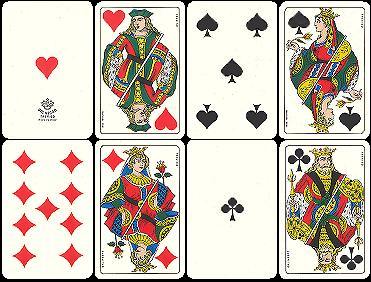
Genoese pattern, by Dal Negro (Italy) |
Another place where the Belgian pattern took root, becoming
the local design, is the Italian city of Genoa and its surroundings. In fact,
the Genoese courts are identical to those of the French 19th century version,
i.e. without indices.
A slight difference is the shield held by the Genoese knave of Clubs (a card that works well as an indicator of these patterns): its shape is more elaborate, with a pointed top edge and concave sides, as shown below. The symbols featured, though, are basically the same. |
The identification scheme based on these shapes is obviously deceived by hybrid editions, such as the Tunisian one previously shown, without indices (suggesting a Genoese pattern) but with a Belgian shield.
With regard to colours, most details that in the Belgian cards are blue, in the Genoese pattern change to deep green. |
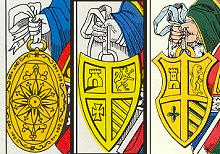
the different shields of the knaves of Clubs:
French pattern (left), Belgian and Genoese |
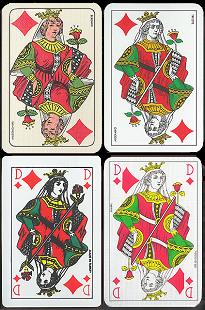
top row: Genoese pattern
(by Masenghini and Modiano, Italy)
bottom row: Belgian pattern
(by Ken and Master De Lux brands, Turkey) |
Among Italian regional patterns, significant similarities with the
Belgian and French styles, can also be found in the traditional cards used in Piedmont region (picture below),
actually located just north of Genoa. In this case, though, some further differences widen the gap discussed above: not only indices are missing, but courts are doubled horizontally (not diagonally), and decorative
girdles appear around three aces, or all four of them, according to the edition.
A few more subjects from the Piemontesi deck can be viewed
by clicking here.
Furthermore, in some editions all Genoese courts feature pink or flesh-colured skin,
a detail never found in the typical French and Belgian styles (with the exception of very few
editions produced for overseas markets).
Lastly, in some editions the doubling line is no longer marked by a band or stripe
(see picture on the right), but by a simple line.
|
Still today, Genovesi decks come in three different compositions: a 32-card version, similar to the original French pack (though without the Joker), a 40-card version similar
to most other Italian regional packs, with values from 1 (ace) to 7 and three courts but,
again, no Joker, and a 52-card version with 2 Jokers. The latter is produced by manufacturer
Modiano both as Genovesi and as Baccara (no visible difference can be told
between these two versions). |
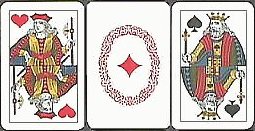
Piedmontese pattern (by Modiano); note the
horizontal doubling, and the ace's decoration |

French ace of Clubs, Genoese ace of Hearts,
and two Turkish aces of Hearts and Diamonds |
By comparing the aces of the several varieties described so far, some further differences can be found:
- traditional French decks feature the manufacturer's name or logo on the ace of Clubs,
which is the only one of the four decorated by a small wreath surrounding the suit symbol.
- Belgian aces are plain, usually lacking the brand's name or any special detail. Turkish
versions too are plain, but some editions carry the brand's name on the aces of Hearts and
Diamonds (this is not a standard detail, though).
- Genoese decks, instead, show the brand's logo on the ace of Hearts, the card which also
carried the tax stamp; the remaining aces do not have any further decoration.
|
The national pattern is still so popular in France that some fancy editions too have been made keeping in mind traditional decks. The sample on the right shows a non-standard
single-ended version which artist Claude Weisbuch created for Grimaud-France Cartes: the
indices for the first pip card of each suit, "1", have been turned into a more international "A", and the suit signs have been redrawn, but the twelve courts have maintained their historical names.
|

non-standard French edition, illustrated
by Claude Weisbuck, manufactured by Grimaud/France Cartes |
go to part 2